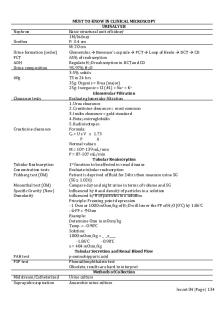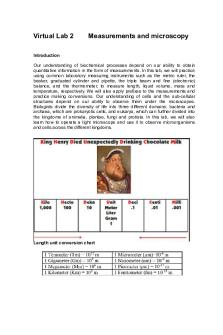PSB Microscopy Worksheet PDF

| Title | PSB Microscopy Worksheet |
|---|---|
| Course | PRACTICAL SKILLS IN BIOSCIENCES 1 |
| Institution | Glasgow Caledonian University |
| Pages | 5 |
| File Size | 150.5 KB |
| File Type | |
| Total Downloads | 82 |
| Total Views | 128 |
Summary
biology tutorial work...
Description
Microscopy Worksheet In order to complete this worksheet you will need to refer to the textbook “Practical Skills in Biomolecular Sciences” by Reed et al. p180 Chapter 29. You may also wish to refer to the microscopy laboratory notes and the skills you acquired during the microscopy laboratory session The completed worksheet will be submitted as part of the Practical Skills in Bioscience (PSB1) module portfolio. The Microscope. Below is a diagram of the light microscope. Label the numbered components.
1
Function of microscope parts Give a brief definition of each of the following microscope components. Condenser lens
Iris diaphragm
Objective and eyepiece lenses
Different forms of microscopy There are two main forms of microscopy. Light microscopy is one; name the other.
What benefits does this second type of microscopy have over light microscopy?
Functions of the microscope The microscope magnifies objects but resolution is also important. Define what is meant by resolution in terms of microscopes.
2
Oil immersion objectives The oil immersion objective on our microscopes has a magnification of 100x and is the most powerful lens on the microscope. In order to provide maximum resolution it must be used with immersion oil filling the space between the objective lens and the top of the slide. The oil has the same refractive index as the glass lens. State how this oil improves the image observed.
Magnification The magnification of a light microscope is calculated by multiplying the objective magnification by the eyepiece magnification. Which lens combinations will give you magnifications of (a) x40 (b) x 1000
Measuring objects using the microscope The measurement of structures under the microscope can be performed using and eyepiece graticule in combination with a slide micrometer. The graticule is a circular piece of glass, inserted into the right eyepiece. Marked on this is a scale, which is subdivided into 100 equal units. These units are arbitrary – they will depend on the objective lens magnification in use. Hence it is necessary to calibrate the eyepiece units to be able to give measurements in um (micrometers). A special slide known as a micrometer slide is used to calibrate these units. On the micrometer slide is a line with markings 10 m apart. The microscope is set up such that the eyepiece graticule line is superimposed on the micrometer slide line. Then the equivalent micrometer slide units in um for each eyepiece unit can be read off.
3
Measuring using a Micrometer Example:
Eyepiece Scale
Micrometer Slide Scale Calibration calculation 10 eyepiece unit = 20 micrometer slide units The micrometer slide is calibrated and each division is equal to 10 m 10 eyepiece units = 200m 1 eyepiece unit = 20m The calibration must be performed at each magnification as the micrometer slide will appear larger at higher magnifications. Once the microscope has been calibrated the micrometer slide is replaced with the slide of the object to be measured and its size can be estimated in eyepiece units. The size of the object can then be calculated in m using the calibration information. Eyepiece scale
Cell
The cell above is 5.8 eyepiece units long. From the calibration information each eyepiece unit is 20 m therefore the cell is 5.8x20m =116m in length.
4
Calculations 1. Calculate the size of 1 eyepiece unit given the following information 25 eyepiece units = 10 slide units
therefore 1 eyepiece unit = m A cell measured using this eyepiece was 3.5 units Its length is m 2.
Calculate the size of 1 eyepiece unit given the following information 12.5 eyepiece units = 10 slide units
therefore 1 eyepiece unit = m A cell measured using this eyepiece was 6 units Its length it is m
3
Calculate the size of 1 eyepiece unit given the following information 40 eyepiece units = 2 slide units
therefore 1 eyepiece unit = m A cell measured using this eyepiece was 10 units Its length it is m
4.
Calculate the size of 1 eyepiece unit given the following information 100 eyepiece units = 8 slide units therefore 1 eyepiece unit = m A cell measured using this eyepiece was 20 units Its length is m
5...
Similar Free PDFs

PSB Microscopy Worksheet
- 5 Pages

different microscopy
- 4 Pages

PSB 2000 Notes – Unit 1
- 5 Pages

CM-handouts - Clinical Microscopy
- 32 Pages

Microscopy - Lecture notes 2
- 3 Pages

MUST-KNOW Clinical Microscopy
- 43 Pages

Microbiology labster microscopy
- 4 Pages

microscopy workshop 2 analysis
- 14 Pages

Greenwood Microscopy Mitosis Lab
- 13 Pages

Optics & Microscopy summary
- 27 Pages

Electron Microscopy 1
- 1 Pages

K2-PSB KONSEP DAN MANFAAT,
- 15 Pages
Popular Institutions
- Tinajero National High School - Annex
- Politeknik Caltex Riau
- Yokohama City University
- SGT University
- University of Al-Qadisiyah
- Divine Word College of Vigan
- Techniek College Rotterdam
- Universidade de Santiago
- Universiti Teknologi MARA Cawangan Johor Kampus Pasir Gudang
- Poltekkes Kemenkes Yogyakarta
- Baguio City National High School
- Colegio san marcos
- preparatoria uno
- Centro de Bachillerato Tecnológico Industrial y de Servicios No. 107
- Dalian Maritime University
- Quang Trung Secondary School
- Colegio Tecnológico en Informática
- Corporación Regional de Educación Superior
- Grupo CEDVA
- Dar Al Uloom University
- Centro de Estudios Preuniversitarios de la Universidad Nacional de Ingeniería
- 上智大学
- Aakash International School, Nuna Majara
- San Felipe Neri Catholic School
- Kang Chiao International School - New Taipei City
- Misamis Occidental National High School
- Institución Educativa Escuela Normal Juan Ladrilleros
- Kolehiyo ng Pantukan
- Batanes State College
- Instituto Continental
- Sekolah Menengah Kejuruan Kesehatan Kaltara (Tarakan)
- Colegio de La Inmaculada Concepcion - Cebu



